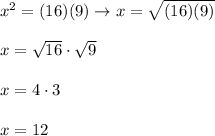Answer:

Explanation:
Look at the picture.
ΔABC and ΔBDC are similar (AA - If two triangles have two of their angles equal, the triangles are similar).
Therefore the sides are in proportion:

We have:
AC = 16
BC = x
DC = 9
Substitute:
 cross multiply
cross multiply

Therefore BC = 12.
Calculate the similarity scale:

Therefore we have the poportion:
 cross multiply
cross multiply
 divide both sides by 3
divide both sides by 3
